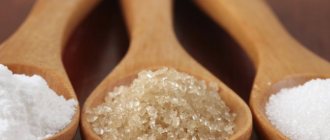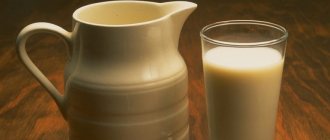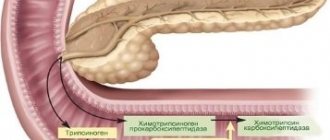Third: without inhaling, make four movements with your chest, simulating breathing. Try not to strain your abdominal muscles. The contraction of the diaphragm should be felt: rising and falling.
Fourth: holding your breath, perform the following actions: one by one, starting from the top, tense the parts of the abdominal press, then forcefully push the lower abdomen up. Do four such pushes.
Repeat steps 4-16 times. The amount depends on how you feel; you should not perform self-massage, overpowering reluctance or feeling discomfort.
In addition to breathing, regular exercises for pancreatitis are also important.
Yoga exercises
Performing yoga asanas for pancreatitis speeds up the recovery process of the pancreas and helps reduce pain. Helps get rid of nausea, heartburn, bloating, constipation, flatulence, diarrhea.
Recommendations for implementation:
- It is advisable to exercise in the morning.
- After eating, start exercising three hours later.
- The room should not be cold or stuffy.
Let's look at effective asanas.
Uddiyana bandha
Execution: Stand with your feet apart. Bend your knees slightly, tilt your body forward, place your palms above your knees. Exhale and press your chin to your chest. Exhale. Pull in your abdominal muscles. Hold for 5-10 seconds. Inhaling, return to the original position, relaxing your abdominal muscles.
Doing this exercise helps relieve constipation.
Paschimottanasana
How to do it: Sit down and stretch your legs. Slowly bend towards your feet and grab your big toes with two fingers. The calves touch the floor tightly. Straighten your arms, raise your head, bend and stretch your back. Hold the pose for several counts.
Breathing is free. As you exhale, bend forward: place your chest on your legs, face your knees, elbows apart and touching the floor. Relax as much as possible. Stay in the pose for at least a minute, preferably five. Breathe as comfortably as possible.
As you inhale, return to the starting position.
The asana tones the gland and rejuvenates the gastrointestinal tract.
Pavanamuktasana
Execution: With your legs straight, lie on your back on the floor. Grasp your right knee with both hands, and as you exhale, pull it tightly toward your chest. Hold for 5-10 counts. Breathe freely. Lowering your leg, repeat the same with the other. Pull both knees towards your chest. Without unclenching your arms, move your knees towards your head and back, and to the sides. Finish the exercise.
The asana helps cope with constipation and flatulence.
Balasana
Execution: get on your knees. Exhale while lowering your pelvis onto your heels. Reach your forehead to the floor, with your arms stretched forward, palms down. Relax, breathe deeply and measuredly.
Regular exercise leads to improved digestion, reduced stress and fatigue.
Remember: exercises for pancreatitis should be stopped immediately if pain occurs.
Simple exercises for physical activity
Walking:
- slow, within 30-40 seconds.
- leisurely, from 50 to 90 seconds.
- on your toes for 35 seconds, with your hands behind your head.
- with raising your legs (do not bend your knees) – 4-5 repetitions.
- with intensive abduction of the arms to the sides and back, stretching them upward (do not bend the palms).
Hand movements:
- move your elbows in a circle (toward and away from the body).
- As you inhale, gently lift it up, and as you exhale, release it.
Lying exercises:
- On a flat surface, on your back, arms extended upward. One at a time, slowly raise your legs without bending.
- On your back, feet on the floor. Slowly, tilt your knees bent to the sides.
- On the stomach. Take your straight legs back one at a time at a fairly fast pace.
The process of performing breathing exercises and therapeutic complexes
It is prohibited to perform such physical exercises during pancreatitis: intense, sharp bending of the body to the sides; run; pull-ups; pumping up the abdominal muscles; squats; push ups; jumping; other exercises that cause sudden movements and shocks. These activities put pressure on the pancreas and cause an attack of pain.
Types of activity suitable for patients with pancreatitis: yoga, qigong, callanetics, exercises on a fitball, swimming, Pilates, walking in the fresh air, as well as other activities that do not require sudden movements.
Physical exercise for pancreatitis should not last more than 20 minutes. After completion, be sure to recover: lie on your back for four to five minutes, completely relaxing your muscles. Palms should face down, legs apart, eyes closed. Then you are allowed to take a shower.
The main rule: during the acute period of illness, exercise with pancreatitis is prohibited!
Source: https://GastroTract.ru/bolezn/pankreatit/gimnastika-pri-pankreatite.html
Exercises for the pancreas: therapeutic exercises for pancreatitis
Exercises for pancreatitis
Pancreatitis is an inflammatory process that occurs in the pancreas.
With this disease, doctors prohibit serious physical activity, since this organ can react to any tension with severe pain.
To improve a person’s condition, he should perform special exercises. The so-called breathing exercises are especially useful for pancreatitis. First you need to take the most comfortable position - you can sit or lie down. Charging consists of performing the following exercises:
- Take a strong breath, then exhale. After this, you need to pull in your stomach and hold your breath for a while.
- Repeat the previous exercise, but at the same time you need to inflate your stomach with great effort.
- Stop breathing mid-inhalation and hold it for a few seconds, after which you can continue inhaling. Then hold your breath again and inflate your stomach for three seconds, after which you need to retract it for the next six seconds. Finally, the stomach should be inflated as quickly as possible and pulled back in. Now you can relax.
- As you exhale, pull your stomach in tightly, stop breathing for a few seconds and relax your muscles. After this, it is good to inflate your stomach as you inhale and draw it in again as you exhale.
All exercises must be repeated four times. This exercise is very useful for pancreatitis, so it should be done every day. Such exercises help improve blood circulation in all organs of the digestive system, they help eliminate the inflammatory process and normalize the functioning of the pancreas.
Of course, therapeutic exercises cannot replace medications or proper nutrition, but regular performance of such exercises will help minimize the threat of relapse of the disease and prevent its further development.
The exercises are simple, they do not require exertion of physical strength, and therefore everyone can perform them. At the same time, you should avoid excessive fatigue, since the pancreas is very susceptible to any stressful situations, including overwork.
Exercises for chronic pancreatitis
Physical exercise for pancreatitis has a positive effect on a person’s well-being and the functioning of the pancreas.
To improve the patient’s condition, it is necessary to perform a set of exercises that improve the functioning of this organ.
It is important to remember that intense physical activity in the chronic form of the disease is contraindicated, so only simple gymnastics is permissible.
For inflammation of the pancreas, it is recommended:
- Slow walking. Duration – approximately 30-40 seconds.
- Walk on your toes, keeping your hands behind your head. Duration – about 35 seconds.
- Walk with your legs raised, but you cannot bend your knees. Do 4-5 reps.
- Jerking your arms back when walking, stretching your arms up with straightened palms.
- Rotate your elbows forward and backward.
- Slowly raise your arms up as you inhale and smoothly lower them down as you exhale.
- Lying on your back with your arms raised up, gradually raise your straight legs up. You should perform this exercise for each leg in turn.
- Lying on your back, bend your knees and slowly tilt them to the right and left.
- Lying on your stomach, move your straightened legs back at an accelerated pace. Perform alternately for each leg.
- Slow walking. Duration – 50-90 seconds.
In addition to special physical exercises, a rational and balanced diet is of no small importance for pancreatitis. It is very important to eat only natural products, and it is better to avoid fatty, smoked, spicy and fried foods.
Pancreatitis is a rather dangerous disease that, without adequate treatment, can lead to very negative health consequences. To prevent this from happening, you should consult a doctor at the first signs of inflammation of the pancreas.
The specialist will select the necessary medications and give recommendations on nutrition and physical activity.
Special therapeutic exercises for pancreatitis can significantly improve a person’s health and prevent further progression of the disease.
Author : Karnaukh Ekaterina Vladimirovna, especially for the site Moizhivot.ru
with exercises for the treatment of diseases of the pancreas and gall bladder
Source: https://zhkt.ru/podzheludochnaya/uprazhneniya.html
Sports activities
Bodybuilding develops skeletal muscles, therefore, together with strength loads on various muscles, they organize the nutrition process, the basis of which is protein food. Human muscles and many organs are made of protein. Thanks to its molecules, the body's immune system is formed. In addition, the protein nature of some hormones and enzymes is noted.
Important information: Kefir and fermented milk products for pancreatitis
Protein has the unique ability to not accumulate like glycogen and fat. Excess protein is excreted through the kidneys, and it is absorbed in the right amount. Its consumption depends on the intensity of physical activity. Muscle growth occurs due to food entering through the gastrointestinal tract.
For this reason, pumping them up with proper nutrition is quite easy.
Pancreatitis and physical activity require the consumption of protein foods. Preference is given to protein of animal origin, because it is easily digestible. Thanks to it, damaged tissue in the organ is restored. When the exacerbation of the disease passes, protein foods are necessary for the synthesis of insulin and digestive enzymes.
For pancreatitis, you can perform a set of exercises that improve blood circulation in the abdominal organs. It is worth remembering that therapeutic exercises for pancreatitis are carried out when the period of exacerbation of the disease has passed. At the same time, it is necessary to monitor how you feel and stop when unpleasant sensations appear.
Although protein is necessary for pancreatitis, it is not advisable to combine bodybuilding with it. Bodybuilding exercises are aimed at muscle growth, and not at restoring the pancreas. Protein shakes and vitamin supplements may cause more damage to the gland. Even at the remission stage, pancreatitis and bodybuilding can negatively affect your well-being.
Features of performing gymnastics by patients with pancreatitis
Gymnastics for pancreatitis can significantly improve the health of a patient suffering from this disease. By performing special exercises, you can improve blood circulation in the pancreas. This helps improve its functioning and prevents exacerbations of the disease.
Moderate exercise can be beneficial even for patients with pancreatitis
Is it possible to exercise during an acute period?
During the period of exacerbation of pancreatitis, any physical activity is contraindicated. This condition is characterized by severe pain, in which a person tries to take a forced position. Thanks to this position, the attack can be alleviated. During this period, doctors recommend bed rest. But this does not mean that you need to lie in one position without moving.
Once the pain is eliminated, you can begin simple exercises. The fact is that prolonged bed rest can lead to congestion in the lungs, which can lead to the development of pneumonia. In addition, blood circulation in the limbs is disrupted and the functioning of internal organs deteriorates. Therefore, experts usually recommend hygienic exercises for such patients.
Prolonged immobility can lead to the development of congestion in the lungs
Set of exercises
Exercise affects the patient’s well-being and the functioning of the affected organ. To maintain its performance, you need to engage in physical therapy. Since heavy loads are contraindicated for this diagnosis, you can perform fairly simple exercises:
- Slow walking – this exercise is performed for about half a minute.
- Walking on your toes - place your hands behind your head. This exercise is performed for 35 seconds.
- Walking with raising your legs without bending your knees - these movements are performed 4-5 times.
- Elbow rotation - done back and forth, while the person must stand still.
- Jerks your arms back while walking, after which you need to pull them up with your palms straight.
- Slow walking in place - performed for about a minute. Walking in place is a simple and effective exercise that can be performed independently, under the guidance of a physical therapy instructor, and also using various exercise equipment
- Gently raising the straightened leg upward - performed in a position on your back with your arms raised up. This exercise is done in turn for each limb.
- Tilts with bent legs in different directions - this exercise is also performed in a supine position.
- Straight leg abduction – performed in a prone position at a fast pace. The movement must be done in turn with each foot.
Exercise will not bring tangible results if a person does not eat right.
If you have pancreatitis, it is very important to eat natural, healthy foods. In combination with doing gymnastics, these recommendations will help you forget about exacerbations of the disease.
https://www.youtube.com/watch?v=5gLP6fcME5I
Therapeutic gymnastics can significantly improve a person’s condition in the presence of pancreatitis.
Performing special exercises allows you to normalize the functioning of the affected organ, eliminate the inflammatory process and even stop the progression of the disease.
The main thing is to strictly follow the doctor’s recommendations. In addition to exercise, it is very important to eat right and take the necessary medications.
The video below presents exercises of the qigong technique to normalize the functioning of the gastrointestinal tract:
Source: https://peptic.ru/pankcreatit/v-domashnix-usloviyax/gimnastika-pri-pankreatite.html
Simple exercises for physical activity
- slow, within 30-40 seconds.
- leisurely, from 50 to 90 seconds.
- on your toes for 35 seconds, with your hands behind your head.
- with raising your legs (do not bend your knees) – 4-5 repetitions.
- with intensive abduction of the arms to the sides and back, stretching them upward (do not bend the palms).
- move your elbows in a circle (toward and away from the body).
- As you inhale, gently lift it up, and as you exhale, release it.
- On a flat surface, on your back, arms extended upward. One at a time, slowly raise your legs without bending.
- On your back, feet on the floor. Slowly, tilt your knees bent to the sides.
- On the stomach. Take your straight legs back one at a time at a fairly fast pace.
Exercises for the pancreas for pancreatitis
Currently, there is a fairly wide variety of various breathing practices that have a positive and beneficial effect on all internal human organs, contributing to their restoration and normal functioning.
Among them, the most famous are breathing exercises by A. N. Strelnikova, which was developed in the 30-40s of the last century to restore the singing voice. In addition, a fairly well-known group of ancient breathing exercises is qigong, which appeared on the basis of Taoist alchemy and Buddhist practices performed for healing purposes.
If you have diseases of the digestive system, doctors strongly do not recommend using heavy physical activity. You cannot go to the gym, practice weight lifting, or speed running. This is due to the fact that the diseased organ is already experiencing difficulties in functioning, and excessive stress on it will not lead to anything good.
During an exacerbation of the disease, a person experiences pain. During this time, the use of forceful physical activity is strictly prohibited. After this period is over, you can try doing exercises for the pancreas.
Exercise for the pancreas
Exercise for the pancreas
Simple gymnastic exercises that help improve the functioning of the whole body are quite effective for pancreatitis, cholecystitis, and liver diseases.
They can be performed at home, they help improve the condition of diabetes and have a fairly large number of positive reviews.
Since the pancreas is located behind the stomach and large intestine, it is quite difficult to influence.
To improve the patient's condition, special breathing exercises are used, which are combined with any physical training.
When performing exercises, it is important to be in a calm state and a comfortable position. An approximate set of exercises that should be used for pancreatitis looks like this:
- Warm-up and warm-up of the whole body, which is carried out using slow walking for 1-3 minutes;
- Hands behind your head, walk on tiptoes for about 2 minutes;
- We continue to move slowly, while raising our leg with each step and straightening it at the knee. Perform approximately 14-16 repetitions on both legs;
- Raising your arms forward and to both sides, while continuing the movement;
- From a standing position, hands on shoulders, slowly rotate shoulders back and forth;
- Lying on your back with your arms raised up, lift your legs one at a time. For each – 5-6 repetitions;
- Slow walking again, which will complete the gymnastics.
Such useful and absolutely uncomplicated exercises, which make up exercise therapy for chronic pancreatitis, will help improve the general condition of the patient.
If it is not possible to do them constantly, you can use daily walks.
Breathing exercises
Breathing exercises
Breathing exercises for the pancreas can be performed in a variety of ways.
It is responsible for stimulating the saturation of the body with oxygen, which creates a favorable picture for the patient’s recovery.
The frequency and regularity of classes is important. Another name for such gymnastics is pancreas massage. This program consists of several actions:
- First you need to take a fairly deep breath and exhale, pull your stomach towards your spine and hold your breath for a while;
- After the next deep inhalation and exhalation, the stomach must be inflated and the breath held again;
- Approximately halfway through a deep breath, pause for a short time and then continue breathing. After this, inflate your stomach for three counts, and for six counts, pull it in as much as possible. When finishing the exercise, inflate your stomach, and then draw it in at maximum speed. After this, relax the muscles and repeat everything from the beginning several times;
- As you exhale, tighten your abdominal muscles and hold your breath for a while. As you inhale, inflate your stomach strongly, and as you exhale, pull it back towards the spine.
All exercises must be performed without pain, and if you are tired, you must finish the session.
The “vacuum” exercise, in which maximum exhalation occurs and the abdomen is simultaneously drawn in, is quite common nowadays.
A prerequisite for this massage is the presence of an empty stomach and intestines.
You should start with 8-10 times, gradually increasing their number.
Complex of visceral-diaphragmatic massage
Complex of visceral-diaphragmatic massage
It is one of the varieties of breathing exercises, which is performed in a certain order and has several stages:
- A long and deep breath, during which the lower part of the abdomen is filled with air, then the middle, and finally the uppermost part;
- Do all the phases that were performed at the first stage while exhaling and in the reverse order;
- Without inhaling, make four chest movements that imitate breathing. In this case, the abdominal muscles should be relaxed;
- Holding your breath, tighten your abdominal muscles, starting from the upper part, and then forcefully push the lower abdomen up.
Each exercise is performed from 4 to 16 times, and it is important to monitor your own well-being and immediately stop performing the exercises if you experience any discomfort.
Yoga exercises
Yoga exercises
As you know, performing yoga techniques promotes rapid healing and restoration of pancreatic tissue, relief from heartburn, nausea, vomiting due to pancreatitis, constipation and other unpleasant issues relating to the gastrointestinal tract.
It is important to conduct classes in the morning, no later than three hours before meals, in a well-ventilated area.
Basic asanas that are used as breathing exercises for pancreatitis:
- Uddiyanabandha - performed standing, legs slightly bent at the knees, body slightly tilted forward, palms on the knees. As you exhale, press the chin to the chest, then the abdominal muscles retract. While inhaling, we return to the starting position;
- Panavamuktasana - lying on the floor with your legs extended forward, you need to grab one knee with both hands, and while exhaling, pull it to your chest. Hold your breath. After this, repeat everything with the second leg. Then pull both knees to your chest and, without unclenching your arms, move towards your head, to the sides and back.
- Balasana - from a kneeling position, exhale, while lowering your pelvis to the floor. The hands are palms down and extended forward.
When using breathing exercises, it is necessary to follow the doctor’s recommendations, combining it with a properly structured diet for chronic pancreatitis and the use of medications prescribed by the doctor. Physical education for this disease lasts no more than 20 minutes and necessarily ends with recovery, during which you need to lie on your back, completely relaxed.
Exercises that will help normalize the functioning of the pancreas are described in the video in this article.
Enter your sugar or select your gender to receive recommendations Searching Not FoundShow Searching Not FoundShow Searching Not FoundShow
Source: https://diabetik.guru/methods/dyhatelnaya-gimnastika-pri-pankreatite.html
Exercises for the pancreas for pancreatitis: exercise and massage
Pancreatitis is one of the most common diseases. The disease is characterized as an inflammatory process localized in the pancreas. Its causes are negative factors: bad habits, viruses and infections, stress and much more.
When treating the disorder and its prevention, exercise for pancreatitis is often included in the complex of therapy. It consists of simple exercises and warm-ups, since strong physical activity should be completely avoided.
Chief gastroenterologist of the Russian Federation: “In order to get rid of Pancreatitis and restore the original health of the pancreas, use a proven method: drink half a glass for 7 days in a row...
Read more…
General recommendations for exercise therapy after relieving an exacerbation
General recommendations for exercise therapy after relieving an exacerbation
When the disease is in acute form, all physical activity should be excluded. When periods of exacerbation occur, a person feels severe pain and is not always able to perform even minor physical activity. He tries to take the most comfortable position so that the pain syndrome is not so pronounced. In this case, bed rest is prescribed.
After the pain is eliminated, the patient can begin exercises for the pancreas for pancreatitis. Gymnastics plays an important role in the healing process. It can be performed at home, in the fresh air and without special equipment.
After the patient is discharged from the hospital, it is recommended to perform simple manipulations that will have an equally effective effect.
Morning exercises and breathing exercises
Morning exercises and breathing exercises
Don’t be too lazy to make it a rule to warm up your muscles every day by doing a simple set of morning exercises.
Light turns left and right, deep inhalations and exhalations involving the abdomen, holding your breath for a few seconds are simple and useful exercises for an inflamed pancreas.
Doctors say that this folk remedy will cure the pancreas in a few uses. You need to brew regular…. Read more…
Many people are interested in whether it is possible to pump up the press with pancreatitis? No, you can’t do this, but doing light special exercises is not only possible, but also necessary. They strengthen the muscles of internal organs, including the pancreas, which, in turn, has a positive effect on the general condition of the patient.
Regular walking
Regular walking
Clean air is always good for the body, especially when you are in a park or forest. At the same time, it is very important not only to sit on a bench, but to make some kind of movement.
It is advisable to spend at least 15-30 minutes outside. Walking must be combined with breathing exercises, which helps improve material metabolism and gas exchange in the lungs and stimulate blood circulation.
It is recommended to inhale the air slowly and deeply, counting 3-4 steps. Then exhale smoothly without holding your breath. If you experience discomfort or dizziness while performing such actions, you must breathe normally. When the breathing process returns to normal, you can repeat it again, but with the duration of inhalation and exhalation for 1-2 counts.
"Massage" of the abdominal organs
"Massage" of the abdominal organs
This complex contains a large number of exercises based on Indian yoga techniques. A number of exercises help improve blood circulation in the pancreas, prevent swelling and stagnation, improve digestion and stimulate the activity of the entire gastrointestinal tract. It is also a good prevention against the development of other diseases.
The complex consists of several types of poses prescribed by the doctor, and is combined with the correct breathing pattern and concentration.
If fatigue or discomfort appears while performing gymnastics, you need to stop and rest a little. Then repeat again, but with less repetitions and intensity.
You should not overexert yourself if you no longer have the strength, you need to rest. When performing such exercises, the main thing is not setting a record, but maintaining health.
For the prevention and treatment of pancreatic diseases, our readers recommend Monastic tea. This is a unique product… Read more…
Remember that physical therapy for pancreatitis does not require you to perform complex tasks, but all recommended actions are aimed at improving your condition.
How is intra-abdominal breathing “massage” performed?
How is intra-abdominal breathing “massage” performed?
Breathing exercises for pancreatitis are an integral part of general treatment. It helps strengthen muscles and prevent the development of such diseases. Intra-abdominal “massage” is performed quite simply - it does not require any special skills.
Below we will consider the algorithm in more detail.
- Take a deep breath and exhale. Then the breath is held and the stomach is slowly drawn in. Next, you need to count to three and relax your abdominal muscles.
- You also inhale, exhale and hold your breath. Then they inflate their stomach strongly, count to three and relax.
- Inhale, and before finishing it, pause for two seconds. Then you can continue to push the abdominal wall out a little, as if the air is being directed to the abdominal area. Next, there is a pause, count to three and at this time the stomach inflates, after which the muscles quickly relax, and the count continues to six. At this moment, you need to gradually retract the abdominal wall. Then exhale and relax the stomach.
- Exhale and strongly draw in the stomach. Then the breath is held for a few seconds, and the abdominal muscles relax. After this, inhale, inflate the stomach well, then exhale and retract it. At first everything will seem difficult, but over time it will become very easy.
The presented physical exercises for pancreatitis and cholecystitis help to change the pressure of the abdominal cavity, due to which a “massage” of the internal organs and pancreas is performed. This kind of gymnastics can be done anywhere, in any position.
The frequency of execution should be at least twice a day. For the first time, three approaches will be enough, after which, each time they are increased and brought to nine.
Basic breathing exercises
Breathing exercises play an important role in healing the body. They promote optimal saturation of cells with oxygen and help the body function properly. In addition, respiratory exercise helps to quickly restore the outflow of enzymes from organs.
Breathing exercises for pancreatitis and cholecystitis should be performed in a sitting position to activate the work of all abdominal muscles. Breathing should be slow and even so that the cells absorb air at the most active pace.
- Take a deep, slow breath, while pulling your stomach in as much as possible, hold your breath for a few seconds, and then gradually exhale. Repeat 3-5 times.
- During a deep inhalation, inflate your stomach as much as possible, and when exhaling, relax it. Repeat 5-7 times. When performing the task, it is advisable to hold your breath for a few seconds between inhalations and exhalations.
- Start to inhale gradually, then stop and tense your abdominal muscles, hold your breath for a few seconds and continue inhaling, then exhale slowly and deeply. Do 3-5 repetitions.
- Inhale as quickly as possible and tense your abdominal muscles, then exhale as much as possible, while relaxing the muscles. Do 3-5 approaches.
These basic exercises are universal for the treatment of pancreatitis and cholecystitis. They should be performed for a few minutes, about 4 times a day. It is important to pay attention to the fact that if the patient becomes dizzy or feels worse while performing tasks, breathing exercises should be stopped.










